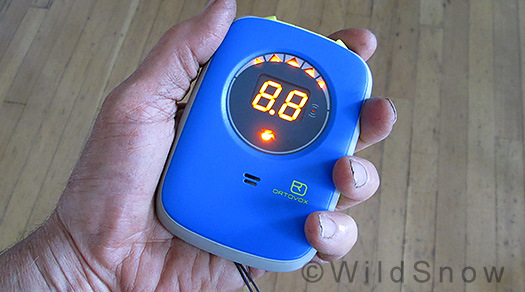
Zoom in hand is better than two left in the truck, or something like that. Shown during self check. I never figured out what the 8.8 meant. It appears after the serial number shows and before the final battery check.
My avalanche beacon priorities: I want something that fits in my pocket nicely, is as light as possible, survives abuse, and homes in easily on one victim. After that, they can throw in the extras such as multiple burial systems or a camera.
Ortovox Zoom (+) at 6.4 oz (182 gr with battery), and fits nicely in the hand and pocket (118 x 80 x 24 mm). Texture is somewhat slippery; easy in the pant pocket but feels like a bar of soap in your hand. Luckily an easily installed lanyard offers security from loss. Optimistic blue and yellow color scheme scream “shelf appeal.” Power is oh-so-simple: one AA battery. Specifications claim the unit is “waterproof,” but nothing more than that. So let’s assume Zoom is “splash proof” and can survive the humidity of being carried under a jacket. We’ll give it a pass on that, but I’d like to see a depth/time rating for water ingress.
Transmission time on that one AA battery is a claimed 250 hours (10 days). We assume that’s at temperatures in the normal zone, but does indicate you could pop a lithium AA cell in a Zoom and leave it to mark a food cache while you’re on a multi-day climb without worrying about returning to a dead signal and possible starvation.
Zoom has the Ortovox “Smart Antenna,” which is said to sense your body position if you’re buried and subsequently switch to an antenna with the most range. Sounds good to me and doesn’t appear to compromise anything else.

Back of Zoom is an appetizing yellow green, just as appetizing as my summer cabin logger hands anyway. On/off switch is, yes, as instinctive as scratching your left foot.
You switch Zoom on and off with a basic intuitive recessed dial switch on the back of the unit. Self check is obvious, and a nice flashing LCD shows you are transmitting (always do a partner check anyway). You switch to rescue mode by moving two slider switches away from each other, which causes a button to pop up. Hit the button, and you’re back to transmit mode. Again, so easy it’s nearly as instinctive as scratching your, um, leg?
Ah, multiple burials: A symbol for multiple signals flashes in the LCD, but you’ll want to go for the closest burial. You then do your pinpoint search for the closest victim, dig her up, switch OFF her beacon, and continue via any of several methods that require practice but work fine if done correctly. Only downside to this is if you’re in a larger rescue group, you can’t “hide” the found beacon while the dig is happening. Hence, you need to be more practiced at dealing with multiples.
Rant: Just about any modern beacon can find multiple burials — some require more expertise than others. But the possibility of multiple victims being dug up alive is another matter entirely. Hence, we always offer our caveat: Ski in small groups, and expose one person at a time to hazard. Really there is no other component of avalanche safety that’s so effective at saving lives, yet so difficult to practice in reality (judging from my own experience, as well as recent accidents in both North America and Europe.)
Yes Virginia, I did test the Zoom. Range was entirely adequate (claimed is 40 meters, and that’s about what I experienced even when searching for another brand). Pinpoint grid search behaved as expected. I was able to hone in on a “victim” buried 24 inches in perfectly reasonable time. During rough search an occasional brief pause was required to let the LCD arrow lock on to the signal, but overall the process was smooth. Remember that with a deeper burial your “cone of inaccuracy” widens no matter how expensive the beacon. That’s what probes are for.
Overall? Despite its somewhat diminutive form factor and reasonable MSRP, Zoom is a “real” avalanche transceiver I’d be comfortable with my partner carrying provided he’d practiced within the last few years (just joking, how about a practicum to start each season, then another a few months later?)
Shop for Ortovox Zoom avalanche beacon.
WildSnow.com publisher emeritus and founder Lou (Louis Dawson) has a 50+ years career in climbing, backcountry skiing and ski mountaineering. He was the first person in history to ski down all 54 Colorado 14,000-foot peaks, has authored numerous books about about backcountry skiing, and has skied from the summit of Denali in Alaska, North America’s highest mountain.
